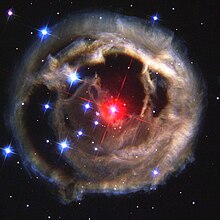This is what znp believes. he believes some crazy woman talks to extraterrestrials from the zeta reticuli star system through an implant in her brain.
The
Nibiru cataclysm is a supposed disastrous encounter between
Earth and a large planetary object (either a collision or a
near-miss) that certain groups believed would take place in the early 21st century.
Believers in this doomsday event usually refer to this object as Nibiru or Planet X. The idea was first put forward in 1995 by Nancy Lieder,[2][3] founder of the website ZetaTalk. Lieder claims she is a contactee with the ability to receive messages from extraterrestrials from the Zeta Reticuli star system through an implant in her brain. She states that she was chosen to warn mankind that the object would sweep through the inner
Solar System in May 2003 (though that date was later postponed) causing Earth to undergo a physical
pole shift that would destro if you y most of humanity.
[4]
The prediction has subsequently spread beyond Lieder's website and has been embraced by numerous Internet doomsday groups. In the late 2000s, it became closely associated with the
2012 phenomenon. Since 2012, the Nibiru cataclysm has frequently reappeared in the popular media, usually linked to newsmaking astronomical objects such as
Comet ISON or
Planet Nine. Although the name "Nibiru" is derived from the works of the "
ancient astronaut" writer
Zecharia Sitchin and his interpretations of
Babylonian and
Sumerian mythology, he denied any connection between his work and various claims of a coming apocalypse. A prediction by self-described "Christian
numerologist"
David Meade that the Nibiru cataclysm would occur on 23 September 2017 received extensive media coverage.
The idea that a planet-sized object will collide with or closely pass by Earth in the near future is not supported by any scientific evidence and has been rejected by astronomers and planetary scientists as
pseudoscience and an Internet
hoax.
[5][
failed verification]
[6] Such an object would have destabilised the orbits of the planets to the extent that their effects would be easily observable today.
[7] Astronomers have hypothesized many
planets beyond Neptune, and though many have been disproved, there are some that remain viable candidates such as
Planet Nine. All the current candidates are in orbits that keep them well beyond
Neptune throughout their orbit, even when they are closest to the Sun.
SOURCE
V838 Monocerotis, a
variable star accompanied by a
light echo, has been
erroneously portrayed as an approaching planet or brown dwarf on a collision course with Earth.
[1]
Claims Earth's imminent collision or near miss with a giant planetoid
Related scientific disciplines Astronomy,
archaeology
Year proposed 1995
Original proponents Nancy Lieder
Subsequent proponents Marshall Masters, Jaysen Rand, Pana Wave,
David Meade, Terral Croft, Paul Begley, Matt Rogers
Pseudoscientific concepts
Pseudoscience consists of statements,
beliefs, or practices that claim to be both scientific and factual but are incompatible with the
scientific method.
[1][Note 1] Pseudoscience is often characterized by contradictory, exaggerated or
unfalsifiable claims; reliance on
confirmation bias rather than rigorous attempts at refutation; lack of openness to
evaluation by other experts; absence of systematic practices when developing
hypotheses; and continued adherence long after the pseudoscientific hypotheses have been experimentally discredited

